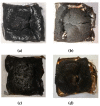Thermal and Fire Behavior of a Bio-Based Epoxy/Silica Hybrid Cured with Methyl Nadic Anhydride
- PMID: 32722585
- PMCID: PMC7466172
- DOI: 10.3390/polym12081661
Thermal and Fire Behavior of a Bio-Based Epoxy/Silica Hybrid Cured with Methyl Nadic Anhydride
Abstract
Thermosetting polymers have been widely used in many industrial applications as adhesives, coatings and laminated materials, among others. Recently, bisphenol A (BPA) has been banned as raw material for polymeric products, due to its harmful impact on human health. On the other hand, the use of aromatic amines as curing agents confers excellent thermal, mechanical and flame retardant properties to the final product, although they are toxic and subject to governmental restrictions. In this context, sugar-derived diepoxy monomers and anhydrides represent a sustainable greener alternative to BPA and aromatic amines. Herein, we report an "in-situ" sol-gel synthesis, using as precursors tetraethylorthosilicate (TEOS) and aminopropyl triethoxysilane (APTS) to obtain bio-based epoxy/silica composites; in a first step, the APTS was left to react with 2,5-bis[(oxyran-2-ylmethoxy)methyl]furan (BOMF) or diglycidyl ether of bisphenol A (DGEBA)monomers, and silica particles were generated in the epoxy in a second step; both systems were cured with methyl nadic anhydride (MNA). Morphological investigation of the composites through transmission electron microscopy (TEM) demonstrated that the hybrid strategy allows a very fine distribution of silica nanoparticles (at nanometric level) to be achieved within a hybrid network structure for both the diepoxy monomers. Concerning the fire behavior, as assessed in vertical flame spread tests, the use of anhydride curing agent prevented melt dripping phenomena and provided high char-forming character to the bio-based epoxy systems and their phenyl analog. In addition, forced combustion tests showed that the use of anhydride hardener instead of aliphatic polyamine results in a remarkable decrease of heat release rate. An overall decrease of the smoke parameters, which is highly desirable in a context of greater fire safety was observed in the case of BOMF/MNA system. The experimental results suggest that the effect of silica nanoparticles on fire behavior appears to be related to their dispersion degree.
Keywords: bio-based epoxy resin; flame retardance; in-situ; methyl nadic anhydride; silica nanoparticles; sol-gel.
Conflict of interest statement
The authors declare no conflicts of interest.
Figures






References
-
- Guadagno L., Raimondo M., Vittoria V., Vertuccio L., Naddeo C., Russo S., De Vivo B., Lamberti P., Spinelli G., Tucci V. Development of epoxy mixtures for application in aeronautics and aerospace. RSC Adv. 2014;4:15474–15488. doi: 10.1039/C3RA48031C. - DOI
-
- Atta A.M., Elsaeed A.M., Farag R.K., El-Saeed S.M. Synthesis of unsaturated polyester resins based on rosin acrylic acid adduct for coating applications. React. Funct. Polym. 2007;67:549–563. doi: 10.1016/j.reactfunctpolym.2007.03.009. - DOI
LinkOut - more resources
Full Text Sources
Miscellaneous

